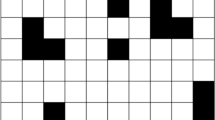Abstract
An algorithm for Cartesian trajectory generation by redundant robots in environments with obstacles is presented. The algorithm combines a raster scanning technique, genetic algorithms and functions for interpolation in the joint coordinates space in order to approximate a desired Cartesian curve by the robot's hand tip under maximum allowed position deviation. A raster scanning technique determines a minimal set of knot points on the desired curve in order to generate a Cartesian trajectory with bounded position approximation error. Genetic algorithms are used to determine an acceptable robot configuration under obstacle avoidance constraints corresponding to a knot point. Robot motion between two successive knot points is finally achieved using well known interpolation techniques in the joint coordinates space. The proposed algorithm is analyzed and its performance is demonstrated through simulated experiments carried out on planar redundant robots.
Similar content being viewed by others
References
Paul, R. P. C.: Manipulator Cartesian path control, IEEE Trans. Systems Man Cybernet. 9 (1979), 702–711.
Taylor, R. H.: Planning and execution of straight line manipulator trajectories, IBM J. of Research and Development 23 (1979), 424–436.
Shin, K. G. and Mckay, N. D.: Selection of near-minimum time geometric paths for robotics manipulators, IEEE Trans. Automat. Control 31(6) (1986).
Lianos, T., Kiritsis, D., and Aspragathos, N.: A direct algorithm for continuous path control of manipulators, Robotics & Computer-Integrated Manufacturing 8(2) (1991), 97–101.
Klein, C.: Use of redundancy in the design of robotic systems, in: Proc. of the 2nd Internat. Symp. on Robotics Research, 1984, pp. 58–66.
Nakamura, Y., Hanafusa, H., and Yoshikawa, T.: Task-priority-based redundancy control of robot manipulators, Internat. J. Robotics Res. 6(2) (1987), 3–17.
Maciejewski, A. and Klein, C.: Obstacle avoidance for kinematically redundant manipulators in dynamically varying environments, Internat. J. Robotics Res. 4(3) (1985), 109–117.
Yoshikawa, T.: Analysis and control of robot manipulators with redundancy, in: M. Brady and R. Paul(eds), The 1st Internat. Symp. on Robotics Research, MIT Press, Cambridge, MA, 1984, pp. 735–745.
Davidor, Y.: A genetic algorithm applied to robot trajectory generation, in: L. Davis (ed.), Handbook of Genetic Algorithms, Van Nostrand Reinhold, New York, 1991, pp. 144–165.
Parker, J. K., Khoogar, A. R., and Goldberg, D. E.: Inverse kinematics of redundant robots using genetic algorithms, in: Proc. of the IEEE Internat. Conf. on Robotics and Automation, Vol. 1, 1989, pp. 271–276.
Nearchou, A. C. and Aspragathos, N. A.: Application of genetic algorithms to point-to-point motion of redundant manipulators, Mechanism and Machine Theory 31(3) (1996), 261–276.
Luh, J. Y. S. and Lin, C. S.: Approximate joint trajectories for control of industrial robots along Cartesian paths, IEEE Trans. Systems Man Cybernet. 14(3) (1984), 444–450.
Kiritsis, D.: Generation of smooth parametric curves by small straight line segments within a given tolerance, in: Compugraphics '91, Semimbra, Portugal, 1991.
Papalambros, P. Y. and Wilde, D. J.: Principles of Optimal Design: Modeling and Computation, Cambridge Univ. Press, Cambridge, 1986.
Harrington, S.: Computer Graphics. A Programming Approach, McGraw-Hill, New York, 1987.
Holland, J. H.: Adaptation in Natural and Artificial Systems, University of Michigan Press, Ann Arbor, 1975.
Goldberg, D. E.: Genetic Algorithms in Search, Optimization, and Machine Learning, Addison-Wesley, Reading, MA, 1989.
Davis, L.: Handbook of Genetic Algorithms, Van Nostrand Reinhold, New York, 1991.
Nearchou, A. C. and Aspragathos, N. A.: A collision-detection scheme based on the convex hulls concept for generating kinematically feasible robot trajectories, in: 4th Internat.Workshop on Advances in Robot Kinematics, Slovenia, July 1994.
Author information
Authors and Affiliations
Rights and permissions
About this article
Cite this article
Nearchou, A.C., Aspragathos, N.A. Collision-Free Cartesian Trajectory Generation Using Raster Scanning and Genetic Algorithms. Journal of Intelligent and Robotic Systems 23, 351–377 (1998). https://doi.org/10.1023/A:1008001930450
Issue Date:
DOI: https://doi.org/10.1023/A:1008001930450




